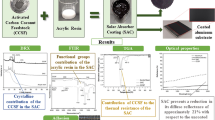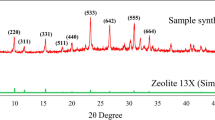The results of investigation into the absorptivity of carbonized rice-husk plant material with regard to solar radiation have been given. It has been shown that an absorber based on leached carbonized rice husk has higher solar absorptivity than an absorber based on carbonized apricot pits with an Apricus coating and an absorber based on a commercial Chinese-made coating. The results of investigation into the physical and chemical properties of carbonized rice husk have been presented. It has been shown that the carbon content in the initial unleached rice husk powder is 82.3%, and after leaching, the percentage of carbon rises up to 93.3%. Based on the results of a BET (Brunauer–Emmet–Teller) analysis, it has been established that leached rice husk has a more developed specific surface (447–641 m2/g) and a higher specific volume of pores (0.27–0.392 cm2/g) than unleached rice husk (127–160 m2/g and 0.054–0.127 cm2/g respectively). The advantage of the considered plant-based carbon materials compared to the exiting coatings lies in their porous structure. Cavities are known to be a model of a blackbody, which is a decisive factor in using a material as an absorber, and, simultaneously, a porous structure has a heat-insulating property.
Similar content being viewed by others
References
Y. Tian and C. Y. Zhao, A review of solar collectors and thermal energy storage in solar thermal applications, Appl. Energy, 104, 538−553 (2013).
O. Ilic, P. Bermel, G. Chen, J. D. Joannopoulos, I. Celanovic, and M. Soljacic, Tailoring high-temperature radiation and the resurrection of the incandescent source, Nat. Nanotechnol., 11, 320−324 (2016).
J. B. Chou, Y. X. Yeng, Y. E. Lee A. Lenert, V. Rinnerbauer, I. Celanovic, M. Soljacic, N. X. Fang, E. N. Wang, and S. G. Kim, Enabling ideal selective solar absorption with 2D metallic dielectric photonic crystals, Adv. Mater., 26, 8041−8045 (2014).
N. Selvakumar and H. C. Barshilia, Review of physical vapor deposited (PVD) spectrally selective coatings for mid- and high-temperature solar thermal applications, Sol. Energy Mater. Sol. Cells, 98, 1−23 (2012).
D. Katzen, E. Levy, and Y. Mastai, Thin films of silica–carbon nanocomposites for selective solar absorbers, Appl. Surf. Sci., 248 (1), 514–517 (2005).
S. K. Kumar, S. Murugesan, S. Suresh, and S. P. Raj, Nanostructured CuO thin films prepared through sputtering for solar selective absorbers, J. Sol. Energy, 2013, ID 147270 (2013).
A. Amri, Z. T. Jiang, T. Pryor, C.-Y. Yin, and S. Djordjevic, Developments in the synthesis of flat plate solar selective absorber materials via sol–gel methods: A review, Renew. Sustain. Energy Rev., 36, 316–328 (2014).
H. Kataura, Y. Kumazawa, Y. Maniwa, I. Umezu, S. Suzuki, Y. Ohtsuka, and Y. Achiba, Optical properties of single-wall carbon nanotubes, Synth. Met., 103, 2555−2558 (1999).
L. A. Falkovsky, Optical properties of graphene, J. Phys. Conf. Ser., 129, 1200−1204 (2008).
A. E. Aliev, M. H. Lima, E. M. Silverman, and R. H. Baughman, Thermal conductivity of multi-walled carbon nanotube sheets: radiation losses and quenching of phonon modes, Nanotechnology, 21, 03570−03579 (2010).
Y. Ito, Y. Tanabe, J. Han, T. Fujita, K. Tanigaki, and M. Chen, Multifunctional porous graphene for high-efficiency steam generation by heat localization, Adv. Mater., 27, 4302−4307 (2015).
J. Bernholc, D. Brenner, M. B. Nardelli, V. Meunier, and C. Roland, Mechanical and electrical properties of nanotubes, Annu. Rev. Mater. Res., 32, 347−375 (2002).
M. Vakili, S. M. Hosseinalipour, S. Delfani, S. Khosrojerdi, and M. Karami, Experimental investigation of graphene nanoplatelets nanofluid-based volumetric solar collector for domestic hot water systems, J. Sol. Energy, 131, 119−130 (2016).
J. Kang, H. Kim, K. S. Kim, S. K. Lee, S. Bae, J. H. Ahn, Y. J. Kim, J. B. Choi, and B. H. Hong, High-performance graphene-based transparent flexible heaters, Nano Lett., 11, 5154−5158 (2011).
K. Mizuno, J. Ishii, H. Kishida, Y. Hayamizu, S. Yasuda, D. N. Futaba, M. Yumura, and K. Hata, A black body absorber from vertically aligned single-walled carbon nanotubes, Proc. Natl Acad. Sci. USA, 106, 6044–6047 (2009).
C. Srinivasan, The blackest black material from carbon nanotubes, Curr. Sci., 94, 974–975 (2008).
M. Zhang, S. Fang, A. Zakhidov, S. Lee, A. Aliev, C. Williams, K. Atkinson, and R. Baughman, Strong, transparent, multifunctional, carbon nanotube sheets, Science, 309, 1215–1219 (2005).
Z. P. Yang, L. Ci, J. A. Bur, S. Y. Lin, and P. M. Ajayan, Experimental observation of an extremely dark material made by a low-density nanotube array, Nano Lett., 8, 446−451 (2008).
Z. Chen and T. Bostrom, Electrophoretically deposited carbon nanotube spectrally selective solar absorbers, Sol. Energy Mater. Sol. Cells, 144, 678−683 (2016).
A. F. Fonseca, R. H. Baughman, and A. A. Zakhidov, Structural model for dry-drawing of sheets and yarns from carbon nanotube forests, ACS Nano, 5 (2), 985–993 (2011).
A. E. Aliev, C. Guthy, M. Zhang, Sh. Fang, A. A. Zakhidov, J. E. Fischer, and R. H. Baughman, Thermal transport in MWCNT sheets and yarns, Carbon, 45, 2880–2888 (2007).
P. M. Martinez, V. A. Pozdin, A. Papadimitratos, W. Holmes, F. Hassanipour, and A. A. Zakhidov, Dual use carbon nanotube selective coatings in evacuated tube solar collectors, Carbon, 119, 133−141 (2017).
N. G. Prikhodko, G. T. Smagulova, N. B. Rakhymzhan, S. Kim, B. T. Lesbaev, M. Nazhipkyzy, and Z. A. Mansurov, Comparative investigation of the efficiency of absorption of solar energy by carbon composite materials, J. Eng. Phys. Thermophys., 90, No. 1, 117−125 (2017).
Author information
Authors and Affiliations
Corresponding author
Additional information
Translated from Inzhenerno-Fizicheskii Zhurnal, Vol. 93, No. 4, pp. 1056–1065, July–August, 2020.
Rights and permissions
About this article
Cite this article
Prikhod’ko, N.G., Smagulova, G.T., Nazhipkyzy, M. et al. High-Efficiency Selective Solar Absorber from Nanostructured Carbonized Plant Raw Material. J Eng Phys Thermophy 93, 1020–1029 (2020). https://doi.org/10.1007/s10891-020-02203-7
Received:
Published:
Issue Date:
DOI: https://doi.org/10.1007/s10891-020-02203-7




